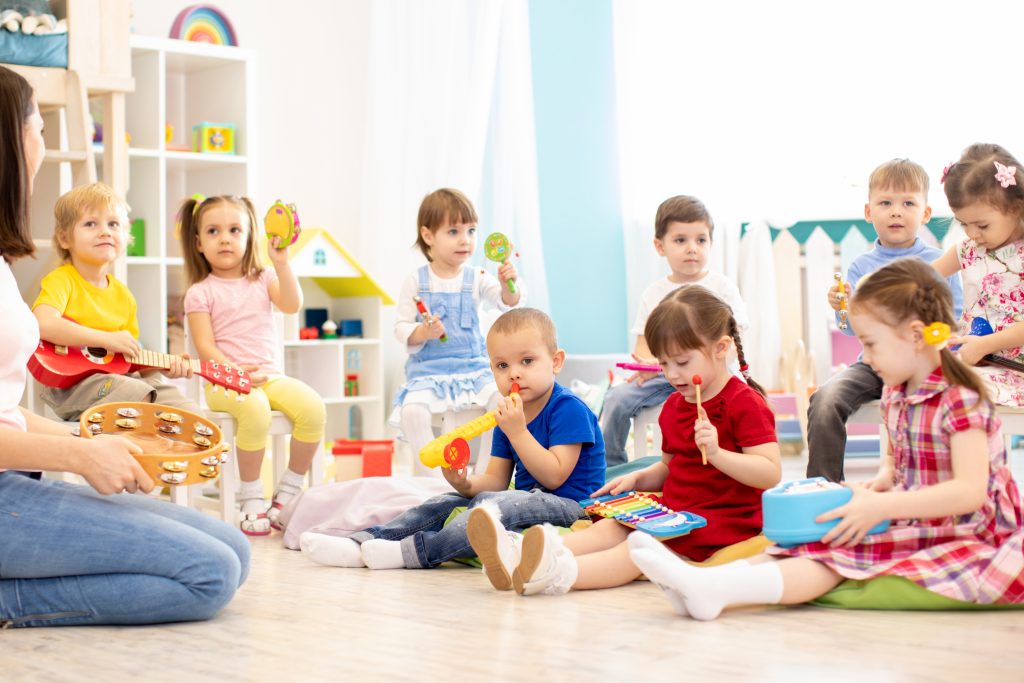Importance of Movement and Music in Facilitating Creativity
In early childhood education, movement and music are crucial for promoting creativity, self-expression, and cognitive growth. Via dance, rhythmic play, and music-making, children learn to express emotion, build motor-coordination skills, and engage with patterns and sounds. These experiences are all playing a part in brain development, memory and the development of imaginative thinking. We have movement activities that allow them to explore boundaries and space, and we use music to add auditory discrimination and in turn can also assist with mood regulation. Bringing these components together in the curriculum gives children the opportunity to explore their world creatively, connect with one another through the arts, and develop confidence through performance and movement (Hallam, 2010).
Source : https://cubbycare.com.au/5-unexpected-reasons-music-is-essential-for-child-development/
Creativity Theories and Perspectives in Movement and Music
Howard Gardner’s theory of Multiple Intelligences emphasizes bodily-kinesthetic and musical intelligences as two significant domains crucial in children’s creative development (Morgan, 2021). Lev Vygotsky’s sociocultural theory also highlights the role of social interaction and cultural tools — for example, music and movement — in promoting creativity. These theories propose that creativity is cultivated through exposure to sensory activities, pretend play, and scaffolded learning. These early experiences with movement and music foster divergent thinking, intrinsic motivation, and novelty in early childhood education settings. Creative educators think of creativity as a fluid, collaborative process that can lead to complex environments in which children can use their bodies and voices to express and create.
Resources, Materials, and Digital Technologies
Instead, teachers can engage children with instruments (drums, tambourines, xylophones), scarves, hoops, mirrors and soft flooring for movement play. GoNoodle, GarageBand, Kiboomu Kids Music, and Sago Mini Music Box are just a few of the digital resources that provide virtual musical experiences.
Apps including Just Dance Kids, Toca Dance and Baby Mozart combine movement and rhythm. Smartboards lend themselves to use with music-based games, and voice recorders allow children to compose and listen to their own musical works.
The integration of real and digital tools creates multi-sensory, inclusive and executive function-enhancing experiences to stimulate creativity and accommodate various learner preferences within music and movement.
Learning Experiences for Different Age Groups
Infants (0–2 years):
- Gentle swaying or bouncing to lullabies and rhythmic tunes to encourage movement and bonding.
- Tummy time with soft musical toys and clapping hands to beats to stimulate auditory and motor skills.
Toddlers (2–3 years):
- Dancing games with scarves to upbeat music, encouraging imitation and free movement.
- Simple call-and-response rhythm activities using shakers or tambourines.
Preschoolers (3–5 years):
- “Music and Movement Storytime” where children act out parts of a story through dance and sound.
- Rhythm circle with drums and sticks to create and follow basic musical patterns.
Early Elementary (6–8 years):
- Group dance projects where children choreograph and perform short routines to chosen songs.
- Music composition activities using apps like GarageBand or Chrome Music Lab to create original tunes.
Three Original Creative Learning Opportunities
0–2 Years: "Tickle Toes Tunes"
Children recline on a padded mat while a caregiver croons a rhyme, tapping their feet in time. This promotes auditory recognition and movement association.
2–3 Years: "Color Dance Circles"
Kids dance inside colored hula hoops as music plays. When the music stops, the teacher calls out a color, and children freeze in that hoop. Develops listening skills, colour recognition and movement control.
3–5 Years: "Create a Dance!"
Children select a mood (happy, angry, sleepy) and then devise a short dance to accompany that movement using instruments and scarves. They take turns performing for one another in a mini-concert.
Critical Reflection and Evaluation
As an early childhood educator, my love of music and movement not only drives my creativity, it also opens doors to innovation. Rhythm and dance is something I've always enjoyed, and that is part of my teaching style. Incorporating movement and music into everyday life create inspired spaces for children to express themselves — emotionally and imaginatively. My creativity traits, including spontaneous improvisation, emotional expressiveness, and openness to child-led initiatives, help me adapt learning experiences according to the interests of the children. When children are allowed to move, sing, and be themselves without judgment, they develop resilience, confidence, and a strong sense of self. This flexibility and sense of innovation also allow me to embrace these new digital tools and exposure to differing world music, providing enriching experiences for children. This type of reflection about my own practices keeps it in check that I am purposeful in supporting creative risk taking and emotional safety. As a result, my creative self empowers me to create movement and music activities that not only honour the goals of the curriculum but also ignite the joy, imagination and lifelong love of how humans express themselves creatively.

Comments
Post a Comment